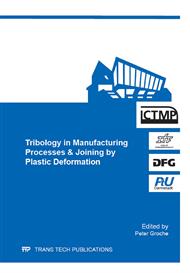[1]
Atamert, S.; Bhadeshia, H.K.D.H.: Comparison of the Microstructures and Abrasive Wear Properties of Stellite Hardfacing Alloys Deposited by Arc Welding and Laser Cladding, Metallurgical Transactions A, 1989, 20(6), p.1037–1054.
DOI: 10.1007/bf02650140
Google Scholar
[2]
De Mol Van Otterloo, J.L.; De Hosson J. TH. M. : Microstructural features and mechanical properties of a cobalt-based laser coating, Acta Materilia, 1997, 45(3), pp.1225-1236.
DOI: 10.1016/s1359-6454(96)00250-9
Google Scholar
[3]
Radu, I.; Li, D.Y.; Llewellyn, R.: Tribological behavior of Stellite 21 modified with yttrium, Wear, 2004, 257(11), pp.1154-1166.
DOI: 10.1016/j.wear.2004.07.013
Google Scholar
[4]
Shin, J.C.; Doh, J.M.; Yoon, J.K.; Lee, D.Y.; Kim, J.S.: Effect of molybdenum on the microstructure and wear resistance of cobalt-base Stellite hardfacing alloys, Surface and Coatings Technology, 2003, 166(2-3), p.117–126.
DOI: 10.1016/s0257-8972(02)00853-8
Google Scholar
[5]
Fouilland, L.; El Mansori, M.; Gerland, M.: Role of welding process energy on the microstructural variations in a cobalt base superalloy hardfacing, Surface and Coatings Technology, 2007, 201(14), p.6445–6451.
DOI: 10.1016/j.surfcoat.2006.12.020
Google Scholar
[6]
Persson, D. H. E.: On the Mechanisms behind the Tribological Performance of Stellites, Digital Comprehensive Summaries of Uppsala dissertations from the Faculty of Science and technology 129, (2005).
Google Scholar
[7]
Persson, D. H. E.; Jacobson, S.; Hogmark, S.: Antigalling and low friction properties of a laser processed Co-based material, Journal of laser applications, 2003, 15(2), pp.115-119.
DOI: 10.2351/1.1514218
Google Scholar
[8]
Kashani, H.; Amadeh, A.; Ohadizadeh, A.: Effect of temperature on the strain induced γàε phase transformation in Stellite 21 during wear test, Materials Science and Engineering A, 2006, 435-436, pp.474-477.
DOI: 10.1016/j.msea.2006.07.022
Google Scholar
[9]
Kashani, H.; Sadeghi Laridjani, M.; Amadeh, A.; Khodagholi, M.; Ahmadzadeh, S.; The influence of volumetric dilution on the strain induced γ→ɛ martensitic transformation in GTAW processed Co–Cr–Mo alloy, Materials Science and Engineering A, 2008, 478(1-2), p.38.
DOI: 10.1016/j.msea.2007.05.061
Google Scholar
[10]
Huang, P.; López, H.F.: Strain induced ε-martensite in a Co-Cr-Mo alloy: grain size effects, Materials Letters, 1999, 39, pp.244-248.
DOI: 10.1016/s0167-577x(99)00021-x
Google Scholar
[11]
Bhansali, K.J.; Miller, A.E.: The role of stacking fault energy on galling and wear behavior, Wear, 1982, 75(2), pp.241-252.
DOI: 10.1016/0043-1648(82)90151-x
Google Scholar
[12]
Fouilland, L.; El Mansori, M.; Massaq, A.: Friction-induced work hardening of cobalt-base hardfacing deposits for hot forging tools, Journal of Materials Processing Technology, 2009, 209(7), p.3366–3373.
DOI: 10.1016/j.jmatprotec.2008.07.039
Google Scholar
[13]
Kashani, H.; Amadeh, A.; Ghasemi, H.M.: Room and high temperature wear behaviors of nickel and cobalt base weld overlay coatings on hot forging dies, Wear, 2007, 262(7-8), pp.800-806.
DOI: 10.1016/j.wear.2006.08.028
Google Scholar
[14]
Farhani, M.; Amadeh, A.; Kashani, H.; Saeed-Akbari, A.: The study of wear resistance of a hot forging die, hardfaced by a cobalt-base superalloy, Materials forum, 2006, 30, pp.212-218.
Google Scholar


